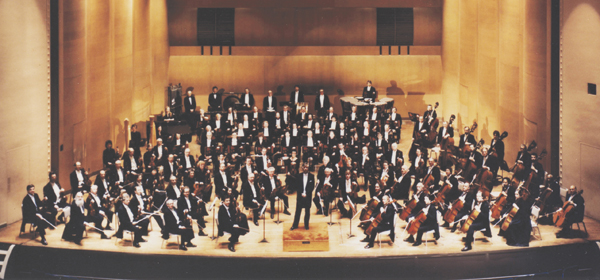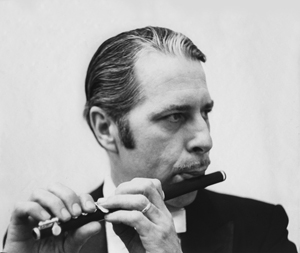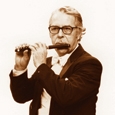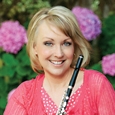.jpg) Listening to Bill Hebert discuss life and music is heart warming and fascinating. At 88 years old, he says the trick to staying healthy is “good vitamins and a good attitude.” Hebert served as the piccolo player for the Cleveland Orchestra for 41 years, starting in 1947. He played under the batons of George Szell (1946-70), Lorin Maazel (1972-82), Christoph von Dohnányi (1984-2002), and Franz Welser-Möst (2002-present) as well as many guest conductors including Pierre Boulez. In addition, he was the flute professor at Kent State University and the Baldwin-Wallace College. Hebert officially retired from the orchestra in 1988, but rejoined the orchestra for a three-week tour to Spain, France, and the Canary Islands in 1991 when Mary Kay Fink, current Cleveland Orchestra piccolo, was pregnant and unable to travel.
Listening to Bill Hebert discuss life and music is heart warming and fascinating. At 88 years old, he says the trick to staying healthy is “good vitamins and a good attitude.” Hebert served as the piccolo player for the Cleveland Orchestra for 41 years, starting in 1947. He played under the batons of George Szell (1946-70), Lorin Maazel (1972-82), Christoph von Dohnányi (1984-2002), and Franz Welser-Möst (2002-present) as well as many guest conductors including Pierre Boulez. In addition, he was the flute professor at Kent State University and the Baldwin-Wallace College. Hebert officially retired from the orchestra in 1988, but rejoined the orchestra for a three-week tour to Spain, France, and the Canary Islands in 1991 when Mary Kay Fink, current Cleveland Orchestra piccolo, was pregnant and unable to travel.
Early Studies
Hebert’s musical studies began at age 8 as therapy for his lungs after he contracted tuberculosis at age 2. He started on the fife and his brother played the drums, so they had a household fife and drum corps. Lessons were 50¢ per week, and at end of the summer, the fife teacher suggested a switch to flute. Flute lessons were $1, a large expenditure for the family since their weekly income was $16 per week. Hebert comments, “It could have been any instrument: contrabassoon, trombone. Any wind instrument would have helped my lungs get stronger. Little did we know playing the flute would end up becoming my profession.”
After the family moved to Cambridge, Massachusetts, Hebert studied with the legendary second flutist of the Boston Symphony, James Pappoutsakis who also arranged for him to play in a training orchestra. “It was an all-Greek orchestra comprised of professionals in other fields who loved to play music. I was one of the few non-Greeks. We played a lot of 7/8 rhythms in those days. Pappoutsakis also arranged for me to play in the MacDowell Club Orchestra where Arthur Fiedler conducted. This orchestra was financially sponsored by the Strauss family, of blue jean fame. If Fiedler was unable to conduct, one the Strauss family would guest conduct. I think the Strauss family lent financial backing to the orchestra for the occasional conducting opportunity. Fortunately as I recall, Strauss was a good enough conductor”
It was about this time that Hebert got his first professional flute. “Mr. Pappoutsakis wanted me to get a better flute, so my mom borrowed the $75 down payment from our parish priest. The flute cost $295. My mother asked Verne Q. Powell if he would take my old flute in trade for some off the price. Powell told her that he would take the flute because he wanted to build a lamp and would use it for that.”
Hebert had always loved the piccolo players in marching bands. “I decided that was what I’d like to play in addition to the flute. I also learned by this time that rehearsals kept me out of mischief in life.” He is a self-taught piccolo player. A cousin bought him his first piccolo as a graduation present from junior high school. This was the piccolo he played to win his audition with the Cleveland Orchestra.
Hebert was part of the National Guard band which was put under federal control after the attack on Pearl Harbor in 1941. The band was immediately shipped out. Hebert continued to play with the Army Band during WWII for the next five years. He was stationed in the South Pacific where his duties included carrying ammunition, being a stretcher bearer, and of course, performing in the ceremonial events and public concerts. There were only 28 men in the band, and he was appointed the drum major since he was the tallest in his unit. “The other men were almost all Italians and much shorter than I was. The band members just needed to be able to see someone.” Hebert was discharged before the war ended and enrolled in Juilliard when he was 23 years old. At Juilliard he studied with Arthur Lora, who played principal flute with the NBC Symphony and on Broadway. Lora had an awareness of the musical business and advised, “If a third tier orchestra has an opening for principal flute, take it. If a second class orchestra has an audition for second flute, take that. If a first class orchestra has an opening for piccolo, take it.” This was the advice that Hebert followed when he heard about the piccolo opening in the Cleveland Orchestra.
Cleveland Audition
The audition process was very different then. “Excerpts were not published and readily available like they are now. When I heard about the job, I wrote my friend George Madsen (piccolo in Boston Symphony) and Pappoutsakis and asked which solos might be asked of me in an audition. Madsen sent me a rather long list, and the only things that were published were some Wagner opera excerpts. I went down to the East Side Library in Manhattan every Tuesday night for a month and hand copied the parts they suggested for two or three hours. By the time of the audition, I had a lot of the major piccolo excerpts prepared and played Shostakovich Symphony No. 7 and a few other things during the audition.
“There was no audition committee. Only Cleveland Orchestra conductor George Szell and the orchestra manager were in the room. Szell asked where I had played before, and I drew a smile from his face when I told him I had been in the Army bands for five years and to please not hold it against me. Szell wanted to hear me sightread, but told me it would be hard to find something new for me to play since I had everything in my notebooks. Szell chose the Wagner ‘Magic Fire Music’ from Die Walküre. Instead of the normal divisi of the parts for 2 piccolos, this part had both piccolo parts written out continuously. I had previously practiced a copy where the divisi parts had been written out, and so as I played the combined part, I left out a 16th here and there in order to take a quick breath. Szell saw that I was not having too much trouble, so then he began conducting, changing the tempo at will, and I followed him like a glove. He said, ‘I want this man’ at the end of the audition. They still had to listen to five other people after me (there were only a few piccolo players auditioning), but he had already chosen me. It was only later after I came back to finalize things that I even played the flute for him.”

Szell and the Cleveland Orchestra
“Szell was a musical giant and a fantastic conductor. He was all business, austere, and rather like a Prussian General in that he did not spend much time with the members of the orchestra. He had no idea how to do small talk. Before the season started, we had nine rehearsals, no concerts, just rehearsals so he could teach the orchestra what he wanted us to do. His rehearsals were so thorough that he could have walked away from the podium and we could have continued on without him. We were so well disciplined.”
Although Szell came to Cleveland in 1946, he did not deem the orchestra ready for a European tour until 1963. During his first year as music director, he fired 20 musicians, and hired 20; he did that the following year as well. Hebert was hired during Szell’s second year of orchestra’s transformation. “Szell balanced personnel of the orchestra between younger players from the United States, particularly the wind players where the level of playing was so strong, and older string players with the European training and traditions.”
Hebert traveled to over 50 countries on tour with the Cleveland Orchestra over the years. The first 13-week European tour in 1963 took them behind the Iron Curtain. “The State Department was sponsoring this tour as a cultural exchange.”
Hebert said, “Szell had two vices, both of which I enjoyed. He liked to play golf and bridge. When we were on tour, we would try and put together games so he could join us. He was quite content to play bridge until he drew a bad hand, then he would excuse himself from the table as if he had a sudden headache.”
“The orchestra played Tchaikovsky Symphony No. 4 my first year on the job. By mistake, I came in one measure too early the first time in the Scherzo. Then on the second statement, I waited an extra bar so it came out right. As we were packing up after the concert, I said to myself, ‘This may be my first year in the orchestra, but it may be my last.’ I just knew Szell would want to speak with me about that mistake, so I decided to beat him to the punch. I knocked on his dressing room door after the concert and said, ‘Maestro, I’m very sorry that I laid such an egg out there on the stage tonight.’ He replied, ‘Yes, it was very nutritious and it should last you for a long time.’”
Hebert related, for one concert, “Szell had programmed the Berlioz Dance of the Sprites which requires two piccolos. John Rautenberg had just joined the Cleveland Orchestra and was playing second piccolo on a silver piccolo. During the morning rehearsal Szell observed the two piccolos, my wooden instrument and Rautenberg’s silver piccolo. Szell stopped the rehearsal and demanded that only wooden instruments be used. Rautenberg, who had just left the Indianapolis Symphony, was low on funds and unable to afford the purchase of a good wooden piccolo on such short notice. He decided to paint his instrument with black shoe polish. At the following day’s dress rehearsal, Szell nodded with complete approval upon seeing the two black piccolos playing the Berlioz with animated gusto.”
Practicing and Teaching
“I used a warm-up routine tailored to the needs of the week. If my part featured lots of low third flute parts, then I would make sure to work on long tones in the first octave on flute. If it was a part featuring lots of high and soft piccolo playing, I would concentrate on that. But always, I would put in a good 30-45 minute warm up routine.” Hebert says that the two areas of piccolo playing that always need the most attention are intonation and playing softly, particularly up high.
In order to get his students familiar with the tendencies of their individual and particular instruments, Hebert asked them to create an intonation map. “I would ask students to play every note in a chromatic scale at a mf level while a friend looked at the tuner. The friend would write down the tendency of each note. Likewise, we would do this for each note at a pianissimo level and a fortissimo level. This is the first step in beginning to work on intonation, just knowing the tendency for each note.”
Another favorite exercise of Hebert’s is the arpeggios from Taffanel and Gaubert (pages 38 and 39 from the complete version: 1, 3 and 5 of the triads). “I suggest that students play this with no crescendo at all, and better yet, with a diminuendo, as you go higher. You need to figure out which muscles are used in order to be in control, in tune, and soft.”
Hebert has about 20 former students who are professionals in the music business, either teaching in college positions or playing in orchestras. Among them are Martha Arrons, Cindy Meyers in Boston, Brian Gordon in Phoenix, and Donald Gottlieb in Louisville. On his teaching style Hebert shares, “I enjoy looking at each student and helping him to solve his individual problems. I take a personalized approach.”
Hebert uses alternate fingerings frequently. When on tour for the last time with the Cleveland Orchestra playing Mahler’s last symphony, (the unfinished tenth), he remarked that the hardest part for the piccolo was the third octave F#. “This came in the first movement, but the second movement is titled Purgatory. I suggested to the conductor that Mahler must have gotten the names of the movements mixed up.” Hebert uses the right middle finger for the third octave F# and also covers the end of the piccolo slightly with his right pinky finger for the desired effect.
Hebert received the NFA Lifetime Achievement Award in 2000 at the convention in Columbus, Ohio. He says he misses concert performances but does not miss the rehearsals. When asked how the business side of the symphony world has changed over the years, Hebert replied, “The role of ICSOM (International Conference of Symphony and Opera Musicians) in helping to better the living standards of symphonic musicians has been monumental. Prior to the establishment of that entity, local union boards had almost complete control over negotiations with symphony managements on wages, size of orchestra, length of service, pensions, and health benefits. The forming of a symphonic representative on the American Federations of Musicians Board opened the door to very helpful negotiations on a more equal footing during contract negotiations.”
* * *
Words of Wisdom
 How do you view your role as a piccolo player in an orchestra?
How do you view your role as a piccolo player in an orchestra?
The piccolo is part of the flute section, of course, but most of the time it’s soloistic. Very little writing uses the piccolo either as a part of the flute section or as one voice in a chord that is supposed to blend. Most of the time, the piccolo is in a leadership role.
What about the common complaint: “I can’t play the flute anymore after I’ve practice piccolo?
I sometimes come away saying that. I think it all depends on the way you practice. I have a colleague in the Cleveland Orchestra who is the second clarinet as well as the Eb clarinet player. I’ve heard him warming up, and he has a unique way of practicing. He’ll play an F major scale on the Bb clarinet and then immediately pick up the Eb clarinet and practice the same fingerings. He practices both instruments in tandem, and he always sounds terrific on both.
For me, the type of challenge I have from week to week determines what I concentrate on. If Tchaikovsky’s Fourth Symphony is coming up, I practice double-tonguing with the metronome set up to q = 160 a good ten days to two weeks before the concert. If the program includes a Shostakovich symphony that has some high notes marked pianissimo, I practice a lot of long tones and slow arpeggios. If we’re playing “Dance of the Mirlitons” from The Nutcracker Suite, however, I play a lot of low register articulation on the flute.
In general, someone who might be put on the spot from week to week to play either instrument should practice both instruments in a systematic fashion. I often get calls from former students who want a brush-up lesson because of an upcoming piccolo audition for some orchestra. They start practicing piccolo only two weeks before they arrive and wonder why they can’t compete. It’s got to be an ongoing process.
Do you enjoy teaching?
I thrive on it. I enjoy working with people who are serious and willing to work. I am basically a problem solver and have always been intrigued with why things happen. In teaching I have to come up with different explanations and solutions for different people. I enjoy a student who is serious, intelligent and has at least a modicum of talent, and lots of problems to solve. Intelligence is important: I have to be able to appeal to a student’s intellect in order for change to occur.
From William Hebert – Playing Piccolo with Pride, Flute Talk, February 1988






